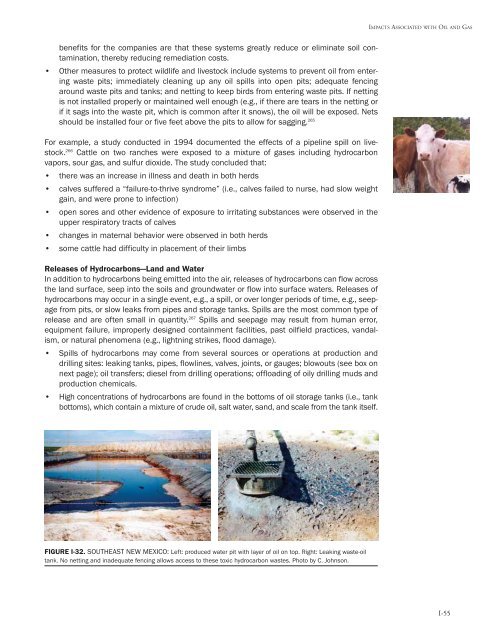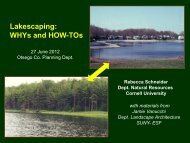Oil and Gas at Your Door? (2005 Edition) - Earthworks
Oil and Gas at Your Door? (2005 Edition) - Earthworks
Oil and Gas at Your Door? (2005 Edition) - Earthworks
Create successful ePaper yourself
Turn your PDF publications into a flip-book with our unique Google optimized e-Paper software.
IMPACTS ASSOCIATED WITH OIL AND GAS<br />
benefits for the companies are th<strong>at</strong> these systems gre<strong>at</strong>ly reduce or elimin<strong>at</strong>e soil contamin<strong>at</strong>ion,<br />
thereby reducing remedi<strong>at</strong>ion costs.<br />
• Other measures to protect wildlife <strong>and</strong> livestock include systems to prevent oil from entering<br />
waste pits; immedi<strong>at</strong>ely cleaning up any oil spills into open pits; adequ<strong>at</strong>e fencing<br />
around waste pits <strong>and</strong> tanks; <strong>and</strong> netting to keep birds from entering waste pits. If netting<br />
is not installed properly or maintained well enough (e.g., if there are tears in the netting or<br />
if it sags into the waste pit, which is common after it snows), the oil will be exposed. Nets<br />
should be installed four or five feet above the pits to allow for sagging. 265<br />
For example, a study conducted in 1994 documented the effects of a pipeline spill on livestock.<br />
266 C<strong>at</strong>tle on two ranches were exposed to a mixture of gases including hydrocarbon<br />
vapors, sour gas, <strong>and</strong> sulfur dioxide. The study concluded th<strong>at</strong>:<br />
• there was an increase in illness <strong>and</strong> de<strong>at</strong>h in both herds<br />
• calves suffered a “failure-to-thrive syndrome” (i.e., calves failed to nurse, had slow weight<br />
gain, <strong>and</strong> were prone to infection)<br />
• open sores <strong>and</strong> other evidence of exposure to irrit<strong>at</strong>ing substances were observed in the<br />
upper respir<strong>at</strong>ory tracts of calves<br />
• changes in m<strong>at</strong>ernal behavior were observed in both herds<br />
• some c<strong>at</strong>tle had difficulty in placement of their limbs<br />
Releases of Hydrocarbons—L<strong>and</strong> <strong>and</strong> W<strong>at</strong>er<br />
In addition to hydrocarbons being emitted into the air, releases of hydrocarbons can flow across<br />
the l<strong>and</strong> surface, seep into the soils <strong>and</strong> groundw<strong>at</strong>er or flow into surface w<strong>at</strong>ers. Releases of<br />
hydrocarbons may occur in a single event, e.g., a spill, or over longer periods of time, e.g., seepage<br />
from pits, or slow leaks from pipes <strong>and</strong> storage tanks. Spills are the most common type of<br />
release <strong>and</strong> are often small in quantity. 267 Spills <strong>and</strong> seepage may result from human error,<br />
equipment failure, improperly designed containment facilities, past oilfield practices, v<strong>and</strong>alism,<br />
or n<strong>at</strong>ural phenomena (e.g., lightning strikes, flood damage).<br />
• Spills of hydrocarbons may come from several sources or oper<strong>at</strong>ions <strong>at</strong> production <strong>and</strong><br />
drilling sites: leaking tanks, pipes, flowlines, valves, joints, or gauges; blowouts (see box on<br />
next page); oil transfers; diesel from drilling oper<strong>at</strong>ions; offloading of oily drilling muds <strong>and</strong><br />
production chemicals.<br />
• High concentr<strong>at</strong>ions of hydrocarbons are found in the bottoms of oil storage tanks (i.e., tank<br />
bottoms), which contain a mixture of crude oil, salt w<strong>at</strong>er, s<strong>and</strong>, <strong>and</strong> scale from the tank itself.<br />
FIGURE I-32. SOUTHEAST NEW MEXICO: Left: produced w<strong>at</strong>er pit with layer of oil on top. Right: Leaking waste-oil<br />
tank. No netting <strong>and</strong> inadequ<strong>at</strong>e fencing allows access to these toxic hydrocarbon wastes. Photo by C. Johnson.<br />
I-55




